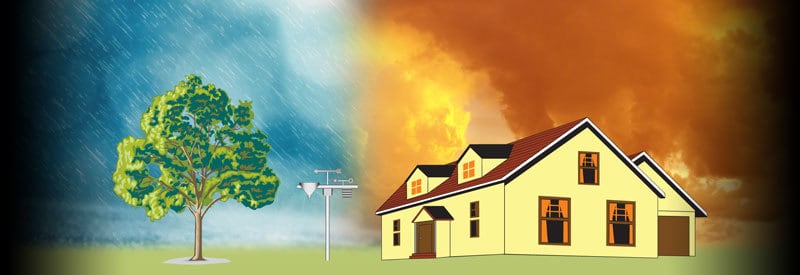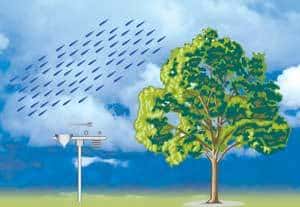How To Install A Personal Weather Station – What To Remember And What To Avoid

Receiving & unboxing a new weather station is an exciting part of owning a weather station. However, there are a few very important factors to consider when installing your home weather station.
Although the majority of quality home weather stations come packaged with a proper instructions manual, some universal principles and general guidelines apply to all weather station installations and are not always included in the device's documentation. In this article, we take a closer look at them.
The Different Parts Of A Personal/Home Weather Station
Home (personal) weather stations come in a variety of shapes and sizes and vary from a single all-in-one unit to a system consisting of several separate components.

For the purpose of this article, we will focus on the typical professional home weather station, which consists of 2 units.
The first unit is the base station (control unit), housing the "brain" and display of the weather station, with build-in sensors also forming part of the unit.
The second unit consists mainly of an array of sensors, housed inside or attached directly to the device. The bulk of atmospheric measurements and readings are performed by this second unit.
The two units are connected to each other via either a fixed wired or wireless connection. (We will take a closer look at these two types of connections later on in this article.)
Positioning Your Sensors Correctly
The process of choosing the correct position for placing your weather station is called siting. Siting is probably the most important part of any weather station installation. It is the most significant part of ensuring the accuracy with which you will be able to measure all the different atmospheric conditions.
The two most important factors that should be taken into consideration for optimal siting is the height of the sensors as well as their distance from other objects. We will look at each one separately.
1) Distance
Distance is the first crucial factor that should be taken into consideration when setting up your weather station. There are two different distances that are of particular importance during the setup process.
The first one is the distance between the outside unit (containing the sensors) and surrounding objects. The second distance is the actual distance between the outside unit and the base station.
Distance Between Outside Unit And Surrounding Objects
The distance between the sensors and surrounding tall objects can influence your readings substantially. Especially variables like temperature, wind speed, and rainfall can be negatively affected by placing your unit too close to such an object like a house or tree.

Trees and walls can cover or throw a "rain shadow" over the unit, giving you a completely false rain gauge reading. The effect of a tree should be obvious, but the "rain shadow" deserves some further explanation.
Say, for instance, the wind is blowing from the house's direction while it is raining, with the rain gauge placed too close to the wall on the opposite side of the house. The wall causes a "rain shadow" where the wind blows the rain over the gauge, causing it to receive only a fraction of the actual rain.
The same applies to wind speed and direction. Large objects will not just influence the wind speed, but also cause the wind to twirl around, making it very difficult to get an accurate wind direction reading. As a result, the anemometer and wind vane should also not be placed close to any tall or large structures.
At this point, you might be getting frustrated and start to wonder where you can actually put you weather sensors where it will NOT be influenced by something. You will be happy to know there is a rule of thumb to follow.
What you may not be so happy to know is that the rule of thumb follows a 4 X 1 rule. This simply means that the weather sensors should be placed four times the distance away from the height of the nearest structure. This means if the structure is 10 feet tall, the weather sensors have to be placed 40 feet away from it.
Yes, I know most of us don't have a backyard the size of a small field, so an open space furthest away from the structure is a good option. (There is a better option. Many weather station owners use their rooftops as a good solution to solve the problem. More on that later on in the next section.)
Distance Between The Base And Outside Unit
I briefly touched on the two ways the base unit and "sensor unit" can be connected to each other earlier in the article, wired and wireless. Both have their advantages and disadvantages.

Wired connections have the advantage of having a constant connection, as well as not being influenced by the different obstacles and barriers that may influence a wireless signal.
The technical difficulties of actually laying a cable, especially if the two devices are several hundred feet apart, combined with the labor and costs involved, can make this a tricky and expensive exercise.
Wireless connections are becoming the standard for most mid-range to high-end home weather stations. The ability to place the sensors anywhere outside the home and seamlessly communicate with the base station without the need for cables or any additional installations makes them very appealing to most home users.
Usually, the maximum distance between the two devices is claimed to be around 300 feet in general. Normal barriers and obstructions like concrete walls or metal and roofing materials bring this distance down to a more realistic 100 feet. Some barriers and other factors (like electronic and radio interference) can cause a loss of connection between the two devices. To any professional relying on a constant, reliable flow of data, this can be a big problem.
2) Height
The second crucial factor during siting for determining the accuracy of your sensors' readings, is your unit's actual physical height above the ground.
The first reason for this is to get an accurate humidity reading. Especially when placed in the back garden or any area that contains plants, grass, or even bodies of water, the accuracy of the hygrometer may be severely influenced. The amount of humidity that plants and bodies of water add to the atmosphere, must never be underestimated.
Another variable that can also be influenced by the surface below the sensors is the temperature. Whether the sensor unit is installed on the ground or on a roof, the surface of each still absorbs and reflects/radiates a lot of the heat from the sun back into the surrounding atmosphere.
As a result, when the sensors are placed too close to the surface, the accuracy of the thermometer will not be able to give an accurate reading. (The reflected/radiated heat from the ground below will add to the atmospheric temperature that is picked up by the thermometer.)
Luckily you don't have to get completely despondent here, as the solution to this problem is not that hard. You just need to ensure that the sensor array is approximately 6 feet above the surface below. This height is sufficient to make the influence of any surrounding objects and surfaces negligible.
Most quality weather systems come standard with brackets to fit the sensor unit (usually to fit around a standard pole). You will be able to source an appropriate pole from many of these manufacturers. You can even save money by purchasing a long enough galvanized pole (to prevent rust) from your local hardware store.
(Remember to take note of the width or type of pole/surface your weather sensor array's brackets will make use of before buying any accessories. Your personal weather station's documentation should be able to supply you with this information.)
Final Recommendations
By now, you should have a pretty clear idea of how to set up your home weather station, what to look out for, and how your surroundings can affect your sensors' readings.
In summary, remember the 4 X 1 rule for distance, and the 6 feet rule for height.

Recommendation: As I already pointed out, most of us don't have a big enough backyard to place the sensor far enough away from any obstruction. Placing the sensor unit on your roof or fixed to its side on a pole about 6 feet clear of the bottom of the roof will give you the best possible readings for all atmospheric conditions.
Please note! This is clearly a potentially dangerous exercise, so have a professional installer do it for you if you are not fully confident and able to do this safely on your own.
Remember that you have to replace the batteries approximately every two years, so make sure the sensor unit is still reachable to replace them, as well as doing the occasional maintenance.
The one last point I quickly want to touch on is the positioning of the thermometer. In general, the temperature should be measured in the shade with plenty of circulation present. As a result, the thermometer should not be placed in direct sunlight.
Luckily, most quality weather stations come standard with the thermometer placed within an isolation shield to protect it from direct sunlight. (Some even have a small fan for air circulation.) As a result, I don't want to go into more detail and confuse you even further with "thermometer protection."
Conclusion
Hopefully, you now understand how crucial the placement of your personal weather station is, as well as how exactly surrounding objects and surfaces can influence the readings of the different sensors that form part of your system.
Luckily, choosing the right placement is not really rocket science, especially if you follow the few simple guidelines laid out in this article. Weather systems have come a long way over the years and have many built-in capabilities that allow it to get the most accurate readings, despite their surroundings. But you can always help it to get even more accurate readings.
Never miss out again when another interesting and helpful article is released and stay updated, while also receiving helpful tips & information by simply following this link .
Until next time, keep your eye on the weather!
